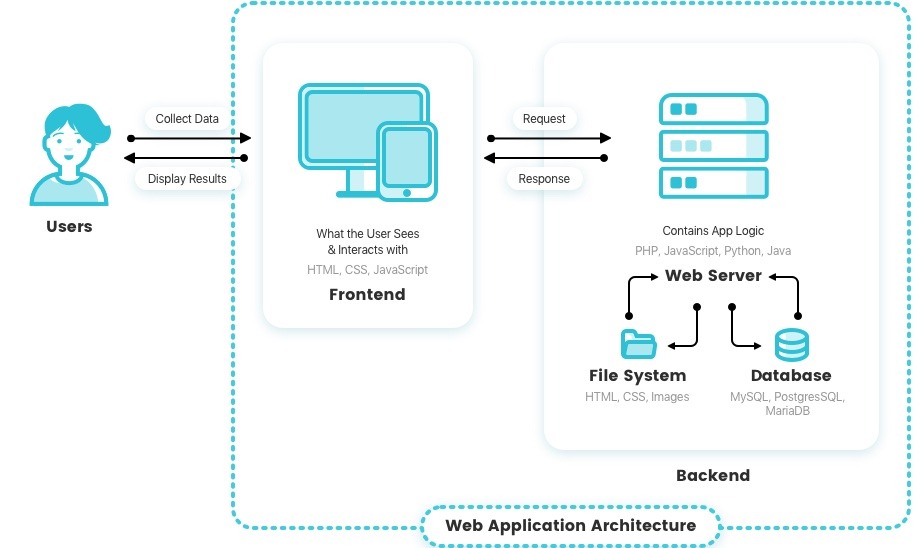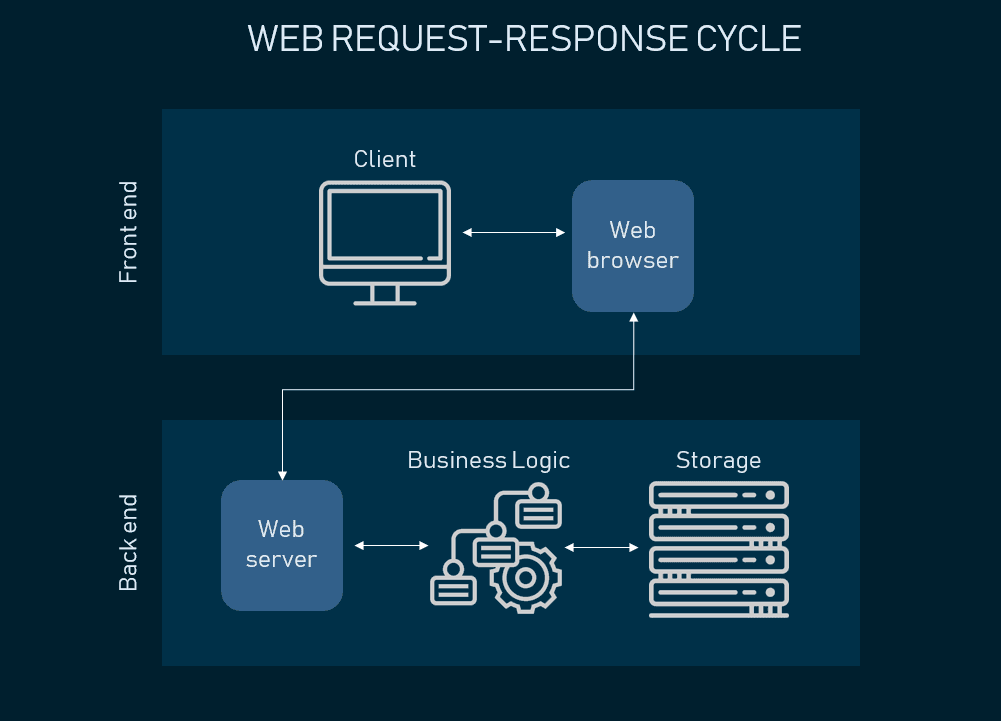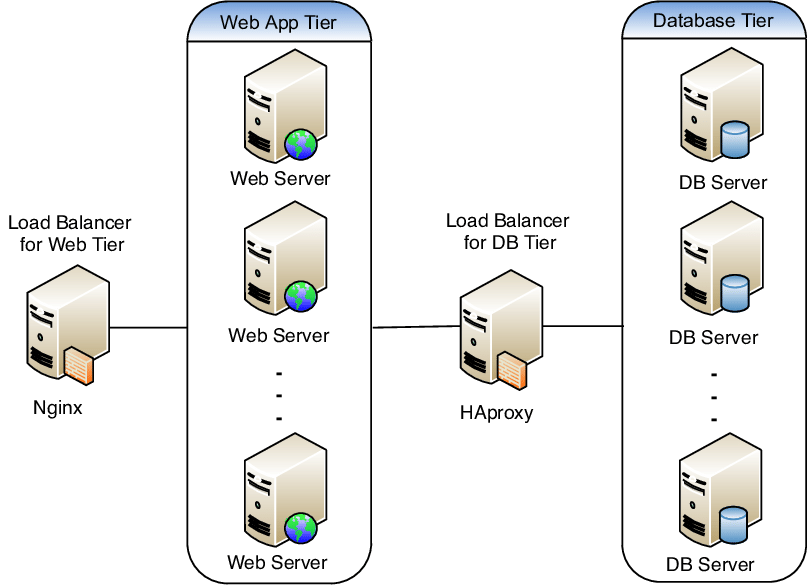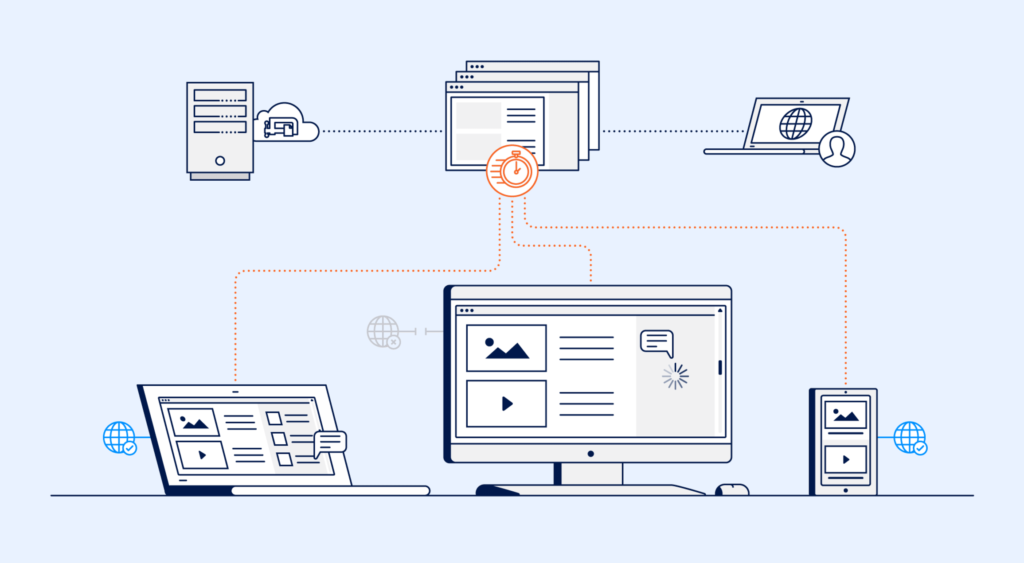
The web application market is an environment that is continuously evolving, incorporating new technologies and increasing safety standards.
In this regard, the proper attention to the foundational design of a web app contributes to maintaining the required robustness, responsiveness, and security of this software. In a web app, this is what solid web app architecture is responsible for.
The definition of web app architecture is broad and depends on the focus of building web applications.
A web application architecture is a model of interaction between web application components. The kind of architecture for web application strictly depends on the way application logic will be allocated among client and server sides.
Technically, it’s the skeleton of a web app, including its elements, databases, systems, servers, interfaces, and all the communication happening between them. In more abstract terms, it indicates the logic behind responses to client and server requests.
When it comes to business benefits, web application architecture is related to the process of creating web applications and planning for their needs in terms of speed, scalability, and security.
This article will provide an overview of modern web application architecture, including its key components, types, and models so that you can invest in this type of architecture with confidence. Let’s get started!
Importance of the Web App Architecture

Improved customer satisfaction: Investing in web application software architecture, or a solid blueprint of its functioning, is needed from the standpoint of user experience.
Being an important part of developing any web app, it makes sure your design is efficient and scalable, which means it will work well under a variety of conditions and avoid downtime. Otherwise, a business app will irritate users with numerous bugs and turn them away from cooperating with it.
Greater business results: The right web application architecture can save your company time and money over the long term, making sure that your website operates at its optimal capacity and runs smoothly without any problems.
In particular, web application system architecture allows web developers to create websites that scale well as traffic increases; it also provides features such as offline access (e.g., Google Docs) that are increasingly expected by today’s consumers.
Better app performance: A solid web app architecture introduces a great degree of flexibility, meaning its adaptiveness to dynamic market fluctuations and customer demands.
The vision on the overall structure makes it easier for developers to work on an app in several modules and introduce new features without interrupting the web app’s work.
Enhanced app security: By envisioning a web app as a system of several blocks, modern web application architecture protects each of its structural elements separately.
This way, overall security increases, making the software stand all the common safety threats like malicious attacks. Thanks to the solid structure, adding new elements won’t ruin the achieved security level.

How Does It Work?
The exact way how web application architecture operates differs between projects, as many of its aspects aren’t dictated by technology but by your project’s needs and business objectives. In other words, web app elements can be adjusted or changed entirely without affecting the overall success of your web app.
At the same time, the typical process of communicating with web app architecture is the following:
- You as a client type an URL in the relevant browser field.
- The browser sends the request to the Domain Name Server to recognize the IP address.
- If successful, the browser sends a request to the server to respond.
- The server directs the request to the data storage to locate the page, request data display.
- If successful, the initially requested data appears in your browser.
In this web application architecture diagram, you can see 3 main sides of the process:
- Client-side, or the frontend for user interaction
- Database server, or an extra component for sending client’s data to the server
- Server-side, or the backend storing business logic, processing requests, and sending responses

Web Application Architecture Diagram
What is a web application architecture diagram? Simply put, it’s a framework that is aimed at simplifying the interaction between components. It’s a client-server application that contains various user interfaces, insights, databases, and so on. Now, let’s take a closer look at the basics of this diagram.

1. DNS
The abbreviation DNS stands for the domain name system. It’s a key element that searches IP addresses and domain names. In this way, a certain server receives a request sent by an end user.
2. Load balancer
It directs incoming requests to one of the multiple servers, which means it sends an answer to an end user. Generally, web app services exist as various copies mirroring one another to enable all servers to process requests in the same manner. Also, the load balancer is an element that distributes tasks in order to prevent them from overcharging.
3. Web app servers
This component is basically an app deployment descriptor. What does it mean? It means that it processes the user's requests and sends JSON//XML docs back to an initial browser. To make it happen, it refers to the backend infrastructure including the database, job queue, cache server, etc.
4. Database
The meaning of this component is pretty much straightforward. It offers a big variety of instruments to perform, delete, organize, and update computations. Mainly, web app servers interact with job servers without any intermediary.
5. Caching service
The component grants easy and quick data storage and search. When the user receives the info from the server, search results will be cached. As a result, future requests will be returned much faster.
These are the scenarios when caching is efficient:
- Slow or repeated computation
- When a user receives similar results for a specific request
6. Job queue (optional)
This one has two components in it which are a job queue and servers that process those jobs. Many web servers operate a big number of jobs of minor importance. A job that has to be fulfilled goes in the queue and will be operated according to the schedule.
7. Full-text search service (optional)
There are plenty of web apps that support search by text feature. After this, an application sends the relevant results to an end user. The whole process is called a full-text search and it can find the requested data by a keyword among all the documents available in a system.
8. Services
Services will be built in a form of a separate application once the web app attains a specific level. Those won’t be super visible among the rest of the web app components, however, web apps and services will interact with them as well.
9. Data warehouse
It’s a way of storing and exchanging data online through the Internet. This element is usually used for storing different types of files like images, videos, etc. The data is sent to a firehouse for its processing, after that the additional data will be sent to cloud storage, and finally, it all goes to a data warehouse.
10. CDN
The abbreviation CDN stands for the content delivery system. This system sends HTML/CSS/JavaScript files and images. Basically, it delivers content taken from the end server around the globe so users can load sources.
Web Application Architecture Components

The applications differ in complexity and functionality, and the number of layers and components changes accordingly. It may happen that an app is so simple that it works as a monolith storing all the web application design architecture in one place.
Nevertheless, a typical web app will consist of multiple components (or tiers) that interact with each other. Usually, the two major groups for web application architecture are user interface and structural web components.
User Interface Components
This group of components composes a visual interface and has no ties to the architecture itself. Being a part of the interface layout design, the set of UI components includes activity logs, dashboards with analytics, and notifications.
Structural Web Components
Client components: The frontend part that appears in the browser and serves as the field to interact with a web application. The client components are developed with HTML, CSS, and Javascript and don’t need an operating system or device connectivity to operate. Simply put, these components are the web app representation.
Server components: The backend part of the web application architecture that is built using Java, Python, .Net, NodeJS, PHP, and Ruby on Rails to create app logic. Also, server components compose the database, meaning a control center for data storage.

A 3-Tier Architecture Overview
The majority of web apps are created through the separation of their principal function into layers/tiers. Respectively, this enables you to quickly and effortlessly replace or upgrade those layers independently. It is called a multi- or a 3-tier architecture.
In a 3-tier architecture there are three layers/tiers:
- Presentation (client) layer
- Application (business) layer
- Data access layer
It’s possible to say that this architecture is the safest and most secure one. It can be explained by the fact that the client doesn’t access the data directly. Application servers can be deployed on multiple machine providers which enable higher scalability, increased performance, and better efficiency.
Each tier can be scaled independently, therefore, this architecture can be scaled horizontally. In addition, it also significantly improves the overall data integrity as data will go through the app server which is the one that decides exactly how and by whom data will be accessed. This amazing perk is an easy and cost-effective solution in case of new company management.
Layers of Modern Web Application Architecture
Now, let’s take a closer look at each of the three web application architecture layers.
When we are talking about the presentation layer we imply the front end of an app. This layer includes such elements as static content and dynamic interface that are visible to end users. The environment of this layer is any browser. Among the technologies that are used in this case, we can name HTML, CSS, or JavaScript. The potential frameworks to choose from include Angular, React, and Vue.
Speaking of the business layer which is also referred to as the application layer, is a part of the app backend. The web app’s backend determines business logic and responses to browser requests that are sent to the presentation layer. It consists of the core application logic and outlines all internal flow for data and requests. The most convenient environment in this case is servers, serverless cloud platforms, or PaaS. Among the programming languages that are used in this case, we can name PHP, Java, Python, Ruby, or JavaScript. The potential backend frameworks to choose from include Django, Express, Spring, and Laravel.
And the last but not least layer is the data access layer. The data access layer is closely linked with the business layer as it gets needed information from the servers. In its turn, the data service layer separates business logic from the client side while processing requests.
It is an app backend part that contains databases and DBM ( database management systems) that collect, manage and store data. The environment can be the same as the application layer. Among the Database management systems, we can name MySQL, PostgreSQL, MongoDB, and so on.
All the layers work independently and communicate with each other through the relevant components.
Models of Web Applications
Enterprise web application architecture models differ based on two criteria: the number of servers and the number of databases. To pick the best one, you should carefully revise your aims and constraints and find the most appropriate one for the current stage of business development.
One Web Server, One Database Model
- The simplest: You have only one server and one database for all the requests and responses.
- Relatively unreliable: If the single server goes down, your app will shut down immediately.
- Relevant for testing: These days, one web server, one database model is too old for real apps. However, it’s a great way to test your web app idea and overview the fundamental design of your web app as an MVP.
Multiple Web Servers, One Database Model
- Stateless architecture: There is no single web server for data storage. When a client inputs information, the relevant server writes it to the sole database managed outside.
- Relatively reliable: As there are more than two servers in the model, a backup server is always available.
- One database availability: Dangerous in terms of possible website crash.
Multiple Web Servers, Multiple Databases Model
- The most efficient: No single point of failure, as there are several web servers and databases.
- Flexibility: You have at least two options for database storage, so you can choose to keep identical data in all of them or distribute information.
- Some information can be lost: In the case of a crash, you won’t lose your entire web app. Nevertheless, some data will be lost. To prevent this scenario from happening, it’s better to install load balancers.
Types of Web Application Architecture

A web application architecture type is a particular pattern under which the components interact with each other. In other words, it shows the way app logic lets the client side and server side communicate.
To make the right choice here, it’s also relevant to check your business requirements, along with technical information about features, functionalities, and the desired app logic.
Single Page Application Architecture
This web application architecture is designed to show relevant content only. To make this happen, it first loads the relevant web page and then dynamically updates the representation of its content with the requested information only.
In other words, it doesn’t refer to the server for loading new pages but sends requests for the needed parts of the webpage only.
Single Page Applications contribute to smoother performance and a more intuitive user experience.
Pros of single-page app architecture:
- Faster performance
- Improved flexibility of UX
Cons of single-page app architecture:
- Increased testing time
- Possible loss of unsaved progress
- Slower first-load speed
Microservice Architecture
Being the frequent alternative to an unreliable monolithic web application architecture, microservices disperse the functionality to deliver small and lightweight services separately.
In particular, they are loosely coupled and use APIs for communication if a sophisticated business problem arises. This peculiarity eases the developer’s life since it’s possible for individual service components to be built in different programming languages.
Thanks to its flexibility and stability, microservice architecture has gained popularity these days, with businesses like Amazon, eBay, and Netflix adopting it for their complex needs.
Pros of microservice architecture:
- Easier scaling up
- Better fault tolerance
- Simple-to-understand code base
- Independent module deployment
Cons of microservice architecture:
- Difficulties with testing and debugging
- Complex deployment
Serverless Architecture
In web application development, this architecture type, you outsource both server and infrastructure management to a third-party cloud service provider. This way, a web app logic execution won’t intervene in the infrastructure running.
Choosing a serverless architecture is good for companies that want to delegate server and hardware management to a reliable tech partner and concentrate on front-end development tasks instead.
Also, this web application architecture type allows working on small functions in apps. The service providers that assist in server management are Amazon and Microsoft, among others.
Pros of serverless architecture:
- Absence of server management
- Highly scalable
- Minimized latency
- Speed and flexibility
Cons of serverless architecture:
- Security concerns
- High complexity
Progressive Web Apps
Being among the most promising web app trends since 2019, progressive web apps offer a convenient and effective user experience available from any browser and device through a shared URL.
The application of progressive web apps is wide, including industries like entertainment, finance, and eCommerce. Their key benefits include lightweight, cost-effectiveness, cross-device nature, ability to attract web traffic, and a fully functioning app experience.
Pros of progressive web app architecture:
- Browser availability
- Mobile-first approach
- Increased traffic
- Effective offline performance
Cons of progressive web app architecture:
- Restricted browser support
- Narrow utilization of native APIs
Web Application Architecture: Best Practices and Tips
Here, we’ve gathered the top 5 recommendations for business owners to consider while working on web app architecture for their projects and building cooperation with tech partners.

1. Think of a proper web application architecture at the earliest stages
Without a comprehensive structure, your application will turn into a labyrinth of messy elements and components that are too hard to handle.
2. Don’t copy somebody’s success
The top mistake is to pick a web application architecture of a successful company and simply replicate it. In reality, a successful architecture is one that corresponds with your business goals and ideas, not theirs.
3. Pay attention to your technical limitations
It’s not always possible to get the best and most successful elements in your web application architecture. However, with the proper attention to quality attributes and realistic business expectations, you will get the maximum from all the components you have.
4. Eliminate the problems right away
Don’t wait for the web app release to fix the problems in its architecture. The earlier you address the issues, the more reliable core features it will have.
5. Create a checklist of successful web app features
To make sure your web app has achieved its goal, it’s good practice to note your expectations from it at the very beginning and discuss their possibility and measurable KPIs with your tech partner.
The possible checklist may include these features:
- Overall system flexibility
- Components can be reused
- Well-written code
- Ability to scale
- System stability
- Easy bug detection
- Sticking to security standards
- Fields to work with user feedback
- No crashes
- Easy-to-use
- Responds fast
- Can be deployed automatically
Consider Intellectsoft Your Trusted Web App Development Partner
So, the success of web development services is always closely connected to its architecture. In this regard, we recommend each business owner and their software development team dedicate attention to picking the best architecture design for the project.
In the future, the time spent on this stage will lead to thousands of dollars and lots of time and nerves saved on fixing errors in the core app functionality.
If you need high-level assistance in building a secure and modern web application architecture, we’re here to help! Contact the Intellectsoft team, and we’ll build together the software solution that perfectly fits your exact business needs.
FAQ
How to know what web app architecture will fit my needs?
First of all, it’s essential to define your business goals and objectives. Once you do this it will be so much easier to decide on what specific type of web application architecture you should opt for. However, if after reading our detailed guide you still don’t know which type to choose then we recommend you contact our professional team and we will gladly evaluate your project and will suggest the most relevant solution in your particular case. In addition, we will be able to provide you with the approximate costs for selecting and creating web application architecture delivered by Intellectsoft.
What are the reasons to treat a web application system architecture seriously?
There are multiple benefits of a web application architecture that should motivate you to treat it really seriously. First of all, it enables very simple and fast integration of new features into your application. In addition, web architecture has high flexibility and scalability which is also very beneficial for your project. Moreover, working with the right web application architecture will decrease the time spent on web development. It also goes without saying that this solution is very cost-effective and will grant you exceptional safety.
